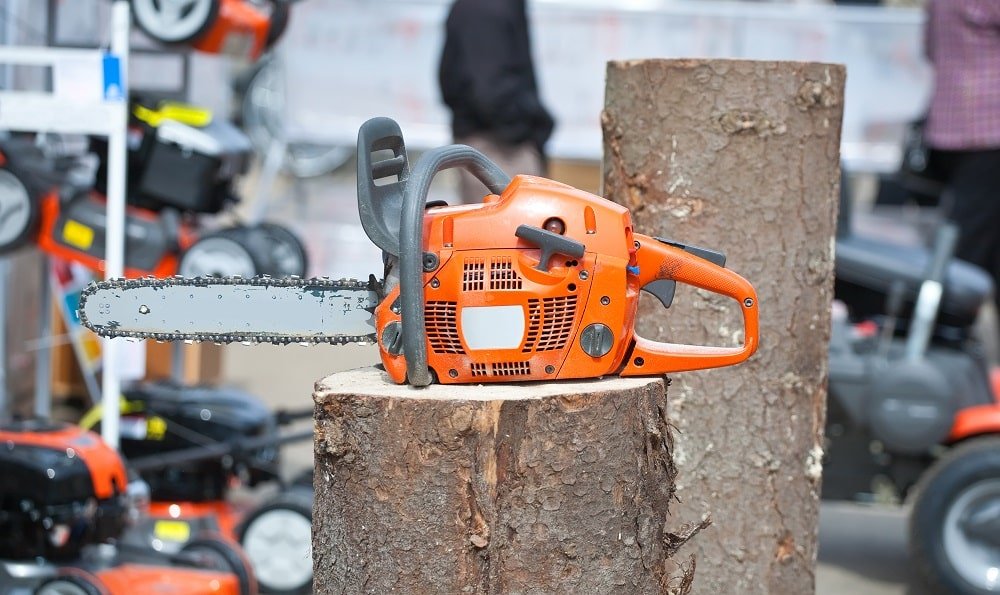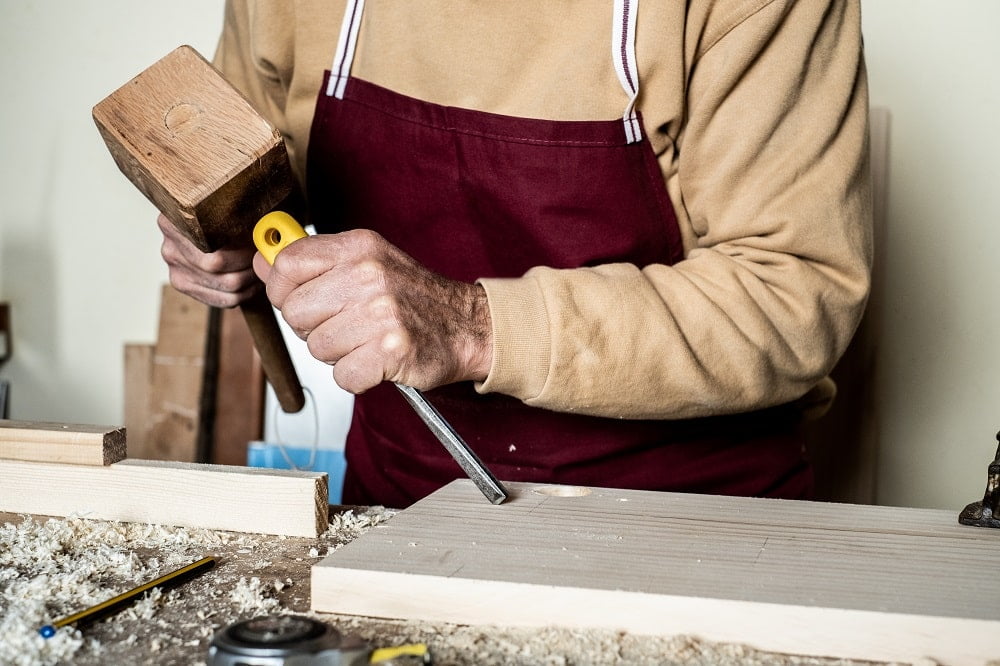There aren’t many of us who haven’t wondered at the marvelous material that is wood. Undoubtedly, this is one of nature’s greatest gifts.

Wood has been helping humans since time immemorial. Whether it’s the fundamental operation of lighting a fire or the more luxurious function of acting as furniture, wood has a permanent presence in our lives.
Naturally, woodworking is a craft that is much in demand, and woodworking professionals often conjure up images of saw-wielding workmen. But the truth is, using a saw is just one of the many ways in which wood can be cut.
Don’t believe us? Well, to clear all your doubts, we’ve brought a list of the different ways by which you can cut wood without using a saw. Once you go through the following, you’ll know that when it comes to woodcutting, a saw isn’t the only option.
But before going into that detail, let’s take a quick look at how a saw works.
The Secret Of The Saw

Saws come in various shapes and sizes, but broadly they can be divided into the manual and motorized varieties. Motorized saws are exactly what they sound like, i.e., they make use of a motor to rotate the saw blade.
Manual saws, on the other hand, rely on human skill and muscle power to get the job done. While both types of saws have their own features and utilities, the one thing that is common among them is the blade.
The saw blade is the most essential part of the device. Usually made of durable metal such as iron or steel, this consists of a serrated edge that is teethed to make cuts. The shape, size, and closeness of the teeth change depending on the saw type.
And it’s using these teeth that the saw achieves its woodcutting magic. The process is rather simple if you put some thought into it. And for both motorized and manual saws, the process is the same; only the power source differs.
A saw mainly works by a continued abrasive motion of the toothed edge against the wood. Through vigorous action, the serrated and sharp edge of the saw bites into the wood material, thus making cuts.
These cuts are intensified with the application of manual or mechanical force. Eventually, the wood material gives way to the razor-sharp edges, and the wood is cut.
Other Tools To Cut Wood
From the above, it can be easily understood that cutting wood is not rocket science. With the right sharp edge and proper force, many tools can achieve the same results. And that’s what we’re going to take a look at now. Following are some tools that can cut wood with as good results as a saw.
A Sharp Knife
This is the first, and undoubtedly the most straightforward device that can be used for cutting wood. Knives are one of the oldest tools known to humankind, and woodcutting is one of the many uses that this device can be put to.
But remember, not every knife is suitable for cutting wood. For a knife to cut wood, it needs to be very sharp. So the first thing that you must do before setting out to cut wood with a knife is to sharpen it to the fullest. This can be easily achieved using a file.
Once you’re sure that the knife is sharp enough, now you need to set the wood for cutting. It’s usually seen that wood cannot be cut with a knife at straight positions. So you’ll need to hold the wood at an angle, and then come in with the knife for sharp, swift cuts.
Another method that you can use to cut the wood with a knife is to use the sharp end of the blade to score into the wood surface. Once the scoring is deep enough, you can snap the wood in two. Either way, remember to trim the cut once you’re done to ensure a smooth finish.
A Drilling Machine
Who would’ve thought, eh? But it’s true: you really can use a drilling machine to cut wood. All it takes is a bit of ingenuity, common sense, and a whole lot of precision.
The first step to cutting wood with a drilling machine is to understand how a drilling machine works. A drill is a device for making holes, not straight cuts. So you shouldn’t expect to take the direct route and cut through the wooden piece.
Instead, what you need to do is first draw a straight line in the wood along the length that you want the wood to be cut. This straight line is going to act as a reference line for the operation.
Next, make very close perforations on the line using the drill. Once you start doing this, the wood will get weakened along that line. And as closely made holes essentially act as a single, straight line cut, this gives similar results to sawing.
Finally, once the wood is weak enough, you can simply break it using your hands. However, remember to trim the edges using a sharp knife for that perfect finish.
A Machete
Nope, we’re not talking about the fictional movie character (though he’d do well too, we guess!), but a real machete blade. Think of it as a knife but on a larger scale. Using a machete, you can easily cut any type of wood, and with better style than a saw will ever achieve.
Even easier, since with a machete, you have the advantage of momentum. Many of the same principles apply to cutting wood with a machete as with a knife. First, you’d have to sharpen the blade as well as you can. Use a file for this purpose, or a whetstone if you have one.
Once your blade is sharp enough, mark the wood along the line where you want to make the cut. Make sure to use a vice to hold the wood at a slanted angle, as you’d do when cutting it with a knife.
Now, you need to make deep enough cuts in the wood along the preferred line. For rough cuts, you can even use a hacking motion as with an ax (coming up next). Once you’ve made a cut deep enough, the wood will break along the cut. Then it’s simply a matter of smoothening the edges with the blade.
An Ax
This is one of the oldest and most ideal methods of cutting wood. And although it requires significant labor, the results can be quite satisfying.
The first step that you have to take, as usual, is to sharpen the ax blade. Using an ax, you can easily go for cutting larger pieces of wood. But you need to take certain precautions before going for the initial swing.
First, you need to ensure that the wood is on a firm base, such as a tree stump. Also, the wood should be positioned at such a height that you don’t have to bend over to make the cuts. That’ll help you to deliver even swings that cut equally well on each blow.
Remember, if you’re using an ax for the first time, it might take some getting used to; so be sure to practice well. For best results, try to make a V-shaped notch on each strike, as this allows the blade a larger striking area.
Finally, once you’re down to the last strip holding the wood together, deliver the final blow, and separate the pieces. If you are an experienced ax-wielder, you can even snap the two pieces apart by hand.
A Hatchet
A hatchet is, essentially, a smaller ax. Equipped with a shorter shaft and blade than a regular ax, this tool is meant to be used one-handed. Hatchets are excellent for chopping up smaller wood pieces.
Besides making kindling sized cuts, hatchets can make small tinder savings, and even work well to cut down small trees. And though they are nowhere near as powerful as an ax, they still get the job done rather well.
There’s not much difference between using an ax and a hatchet. Both must be carefully sharpened before commencing the operation, and both require the wood to be held at a comfortable height.
For best results, make sure to practice a few swings of the tool before setting out to cut the actual wooden piece. And if possible, make a marking to indicate the line along which you’d like the cut to be made.
Hammer and Chisel
This is yet another centuries-old technique for cutting wood. And though it’s not meant to give you elegant, precise cuts, still, it gets the job done rather well. Also, this combination ensures that you don’t take a larger chunk from the wooden piece than you intended.
With the chisel also, you need to first sharpen the blade using a file or whetstone. Once done, you then need to secure the wood on a firm surface. Ensure that it doesn’t slip, or else this might lead to accidents.
Now, hold the chisel at an angle of about 20-degrees from the wood surface. While doing so, make sure that the bevelled side faces up, and the flat side is pressed against the wood.
Now, hit the chisel with the hammer to cut into the wood. This is going to be like striking a pretty large nail. For best results, make a mark along the wood where you want the cut to be made.
You’ll need to repeat the process and follow up with multiple strikes of the hammer for the wood to be cut. When it’s done, you’ll get a wood chip which you can easily lever-up with the chisel. Finally, use the sharp edge of the chisel to smoothen the rough edges once you’ve separated the cut piece.
A word of caution: this is an expert level process, so make sure you practice a bit before setting out on the final cut.
A Router
A router is an electric tool that can be used for a wide variety of woodworking tasks, including the cutting of wood. For this purpose, make sure you select a quality device with the right bits; this is essential for the operation to succeed.
The process is pretty simple. First, you need to attach the router bit that has the right gauge for making the required cut. The gauge of the bit you select is usually determined by the depth of the cut needed, so choose carefully.
Then, pull the router trigger up, set the device into the wood, and push down the trigger to begin the cutting process. With steady hands, move the trigger carefully in the direction of the cut.
And once you’re done, release the trigger and remove the device! It’s that easy. However, to get the required depth, you might need to make several passes. This is necessary as cutting too deeply on a single pass may damage the router and break the bit.
What’s more, you can even use a finer gauge bit to smoothen the cut edges. Just be prepared to handle a lot of wood chips along the way.
A Lathe
Surprised you again, have we? Although a lathe is mostly known for working on metal, it can work on wood with equal efficacy. Using a lathe, you can shape and cut wood, create intricate patterns, and make attractive wooden pieces for a variety of applications.
To shape and cut wood with a lathe, you need first to prepare the wood. This is essential to ensure that it doesn’t come off the lathe while paring down. In case you’re starting work on a rough piece of wood, clean it thoroughly before commencing.
Now, lay the piece in place and firmly fasten the faceplate. Take care not to place the screws along the grain, as this may split the wood unevenly. Finally, mark the center of the wood piece, and place it between the lathe centers.
After this, you need to select the right chisel for the job. It’s best to go with one that’ll give you the required depth of indentation. You need to place the chisel on the tool, and slowly advance it towards the turning wood. Over multiple passes, push the tool more deeply into the wood.
Towards the final stage of cutting, increase the lathe speed, and take greater care not to make mistakes. Once done, remove the cut pieces carefully.
A Plane
The final tool on our list, this is a device that you’re sure to have seen in any carpenter’s workshop. A plane is used to cut wood in long strokes that shave off thin strips from the wood. Here also, the primary requirement is a sharp-edged blade.
While sharpening, take care to stick to an angle of 25-degrees for most wood types. For certain soft varieties of wood, you may use a 20 to 23-degree sharpening angle. Also, adjust the depth wheel based on the depth of the cut required.
Finally, plane through the whole length of the wood for making the cut. While doing so, make sure you go in the direction of the grain. This is essential so that you get a smooth surface and don’t damage the wood.
Plane the wood from one side to the other. Typically, cutting wood with a plane requires multiple passes, and the job can be a strenuous one. So be confident that you’re up for it before starting on the task.

Conclusion
And there you have it, folks! The top tools that you can use to cut wood without a saw. Now, that wasn’t too difficult, was it?
Cutting wood is one of the basic operations that any DIY enthusiast or woodwork professional needs to carry out in the course of a project. And while a saw is always the primary choice for cutting wood, it may not always be available.
But able professionals are not daunted by the lack of a tool. Instead, they improvise and make do with what they have. The above were just examples of the many ways in which tools, which we usually associate with other tasks, can be used to cut wood.
A word of advice for those just starting, however. All the tools described here are sharp instruments and need careful handling. So before you set out to cut wood, make sure that you take the required precautions for your safety.
And if you can think of any other tool that can be used to cut wood, then don’t hesitate to let us know. We’re always happy to hear what you have to say.
Till then, cut away! And don’t forget to improvise.
Related Articles
11 Best Wood Chisels to Enjoy Today | Buyer’s Guide
13 Best Tile Saws Reviewed | Buyer’s Guide
13 Best Portable Table Saws for Fine Woodworking | Buyer’s Guide
Simply the Best Stained Glass Ring Saws Reviewed
11 Best Sliding Compound Miter Saws
11 Best Belt Sanders Right Now
13 Best Stud Finders – Review & Buyer’s Guide
